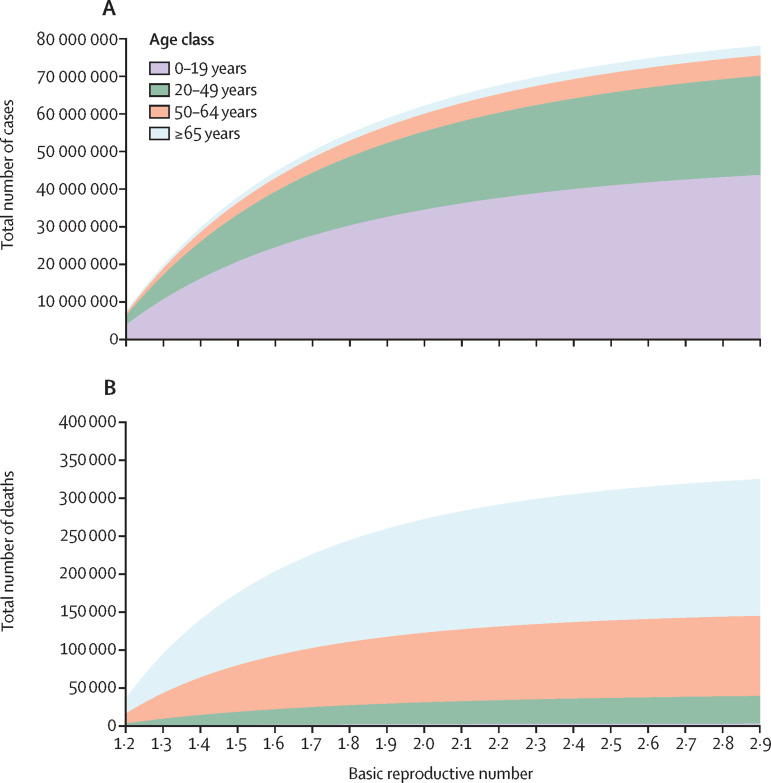As of April 20, 2020, 14 068 people have been infected with severe acute respiratory syndrome coronavirus 2 (SARS-CoV-2) in Africa, of whom 3158 (22·4%) are in South Africa.1 The transmissibility of SARS-CoV-2, combined with the scarcity of crucial health equipment and the challenges of implementing widespread physical distancing and case isolation, poses a grave threat to the continent.
To illustrate the potential burden of SARS-CoV-2 epidemics within the most vulnerable countries in Africa, we simulated a SARS-CoV-2 outbreak in DR Congo in the absence of interventions. Using an age-structured epidemiological model (appendix p 1), and assuming a basic reproductive number of 2·72 (95% CI 2·56–2·87),2 we estimate that there would be 76 213 155 infections (95% CI 74 156 965–77 800 029) and 319 441 deaths (313 079–324 175) in the absence of physical distancing (figure ). Although individuals younger than 20 years account for 42 752 770 (95% CI 41 551 696–43 683 014; 56·1%) of these simulated SARS-CoV-2 infections, individuals aged 50 years and older constitute 280 623 (275 356–284 509; 87·8%) of the deaths in our model prediction. Given the high prevalence of comorbidities in DR Congo, as there is in Africa more broadly, the death toll could even be much higher.3
Figure.
Projected burden of COVID-19 in DR Congo in the absence of any control measures for a range of basic reproductive numbers
The total number of COVID-19 cases (A) and deaths (B) estimated for basic reproductive numbers between 1·2 and 2·9. Details on how we calculated the basic reproductive numbers can be found in the appendix (p 1). COVID-19=coronavirus disease 2019.
Sparse testing capacity makes assessing the true burden of coronavirus disease 2019 (COVID-19) and implementing effective case isolation difficult. For example, by mid-April 2020, DR Congo was only doing around 200 tests per day,4 Senegal around 300 tests per day,5 and Ethiopia around 400 tests per day.5 In addition, there are scarce resources for treating critically ill patients with COVID-19. Compared with the USA, a country with more than 120 000 ventilators, there are fewer than 2000 ventilators spread across 41 African countries, only five of which are in DR Congo.6, 7
Physical distancing and other control measures have been implemented in some parts of African countries, including in the capital of DR Congo. However, authorities in Ghana and South Africa have already begun to consider lifting restrictions.8 Given the dearth of health-care facilities and equipment across Africa, we urge investing heavily in prevention, including lockdowns focused on densely populated areas and shelter-in-place orders for the most vulnerable. Simultaneously, the socioeconomic considerations of the population and the disparate local realities of the 54 African countries must be taken into account. Mitigation strategies must be implemented in conjunction with social protection measures, such as price controls, the waving of utility bills and taxes, and targeted cash transfers.9 A concerted international effort is both moral and pragmatic for achieving this goal. However, on April 14, 2020, the US President announced that the USA will suspend its funding of WHO. Such action would be shortsighted, imperilling the containment of SARS-CoV-2. Protecting Africa is essential, not only for the continent itself, but also to safeguard the rest of the world. Given the potential for SARS-CoV-2 to reseed, even as some countries extinguish their current epidemics, the worldwide population is only as safe as its most vulnerable nations.
Acknowledgments
We declare no competing interests. APG gratefully acknowledges funding from the National Institutes of Health (UO1-GM087719 and 1R01AI151176–01), the Burnett and Stender families' endowment, the Notsew Orm Sands Foundation, and the National Science Foundation, Grants for Rapid Response Research (2027755). We thank Jonathan Mboyo Esole for his insight on the COVID-19 situation evolving in DR Congo.
Supplementary Material
References
- 1.WHO Coronavirus (COVID-19) https://www.afro.who.int/health-topics/coronavirus-covid-19
- 2.MIDAS Network MIDAS 2019 novel coronavirus repository. https://github.com/midas-network/COVID-19
- 3.WHO COVID-19. Situation update for the WHO African region. April 1, 2020. https://apps.who.int/iris/bitstream/handle/10665/331655/SITREP_COVID-19_WHOAFRO_20200401-eng.pdf
- 4.Ministry of Public Health of the Democratic Republic of the Congo. Comité National de Préparation et de Réponse contre la Pandémie de la maladie à Coronavirus 2019 en RDC; Kinshasa; April 6, 2020.
- 5.Our World in Data Daily COVID-19 tests, rolling 3-day average. https://ourworldindata.org/grapher/daily-covid-19-tests-rolling-3-day-average
- 6.Maclean R, Marks S. 10 African countries have no ventilators. That's only part of the problem. April 18, 2020. https://www.nytimes.com/2020/04/18/world/africa/africa-coronavirus-ventilators.html
- 7.Wells CR, Fitzpatrick MC, Sah P. Projecting the demand for ventilators at the peak of the COVID-19 outbreak in the USA. Lancet Infect Dis. 2020 doi: 10.1016/S1473-3099(20)30315-7. published online April 20. [DOI] [PMC free article] [PubMed] [Google Scholar]
- 8.Nordling L. South Africa flattens its coronavirus curve—and considers how to ease restrictions. April 15, 2020. https://www.sciencemag.org/news/2020/04/south-africa-flattens-its-coronavirus-curve-and-considers-how-ease-restrictions
- 9.Gentilini U, Almenfi M, Orton I. Social protection and jobs responses to COVID-19: a real-time review of country measures. April, 2020. https://socialprotection.org/discover/publications/social-protection-and-jobs-responses-covid-19-real-time-review-country
Associated Data
This section collects any data citations, data availability statements, or supplementary materials included in this article.



